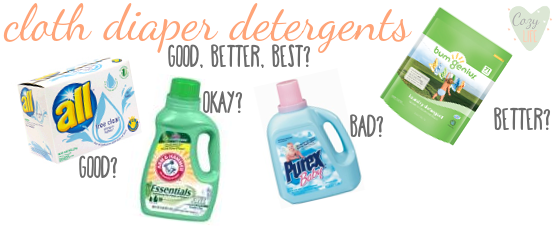What is "Prepping?"
Cloth diaper prep is, simply put, the process in which you take a brand new diaper and prepare it for use. Depending on the type of diaper and the fabric involved, the actual process of prepping your diapers will vary. What does NOT vary is the fact that some form of prep should take place - covers, AIO's, AI2's, pockets, fitted's, prefolds, flats, inserts, soakers, doublers, etc. should be prepped before you put them on your baby.I'll do my best to keep things simple, so I'll just add that "prepping" a diaper for use involves WASHING that diaper, usually multiple times, prior to actually using it. This washing process increases the absorbency of your diapers and cleanses them of any irritants left over from the manufacturing process. So... How do you prep a cloth diaper?
Like I said, it varies. A great deal of this variance is related to the fabric of your diapers. If you want to keep the thought process simple, you can (with a few exceptions) say that diapers made of natural fibers are prepped differently from those made with synthetic material.
Natural Fibers
When I say "natural," I mean fabrics like hemp, bamboo, cotton, etc - These have a naturally occurring oil in the fabric when you purchase the material new. This oil makes the fabric more water resistant, which is something you do NOT want your diaper to be. When prepping these kinds of natural materials, you'll want to wash this oil out of the fabric through repeated washes. The prepping process is also training the material to absorb liquid, which makes it more effective as a diaper.
Synthetic Fibers
When you consider man-made materials used in cloth diapering - like microfiber, TPU (thermoplastic polyurethane), or PUL (polyurethane laminate) - the prepping process is less "involved" than with natural materials. Because these are man-made materials, they do not have any "naturally occurring" oils to worry about and they are engineered to be absorbent from the get-go - these materials just need to be cleansed.
How many times should I wash my diapers before use?
To a certain extent, these numbers are up for debate. Some would recommend more, others less. However, it should be mentioned that your prefolds and fitted's will continue to gain absorbency for a little while through use - so don't give up on a diaper if it's not 100% absorbent immediately after prep. Overnight use with a new diaper might also be tricky, so be sure to plan ahead with extra absorbency layers to accommodate.I also recommend drying between wash cycles - many mom's will say not to bother and just use repeated washes with a dry at the very end - Again, it's up to you and what you're comfortable with.
- Prefolds: 4-6 washes, dry in between
- Natural Fiber Inserts: 2-3 washes, dry in between
- Fitted: 2-3 washes, dry in between
- Synthetic Pockets: 1 wash
- Synthetic AIO's and AI2's: 1 wash
- Synthetic Inserts: 1 wash
- Synthetic Covers: 1 wash
How hot should the water be? Detergent?
Generally speaking, prep should be done with hot water. However, like I mentioned before, there are some synthetic materials that are not meant for use with super hot water, so please read manufacturer labels! With your natural fibers, though - HOTTER IS BETTER.As far as detergent goes, use some during your first wash cycle for cleansing purposes - after that, it's not really necessary. Prepping for absorbency has more to do with the actual water making it's way into the fabric - not the detergent. But, if you want detergent during all cycles, that's okay too. Just be sure that you're using a detergent that is safe for cloth diapers. For more information on detergents, click here to see why not all detergents were created equally!
Can I boil my diapers?
I've never been a fan of this method, simply because it's labor-intensive and I'm ALL for easy! "Work smarter, not harder," as my mom always said! However, there are some women that swear by this method - so we'll agree to disagree.If you are interested in boiling, you definitely can, but only if they are 100% natural materials - like cotton and hemp prefolds or flats. Please, please, please - do NOT boil anything with a pull, or velcro, or snaps, etc. You run the risk of ruining the diaper AND causing a huge mess. Once you're sure that the diaper is okay to boil, the basic process is fairly easy - When boiling, put the material on the stove for 15-30 minutes and follow this by putting diaper in the washer for one cycle before use.




No comments:
Post a Comment